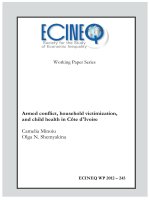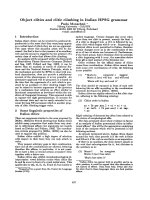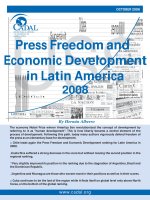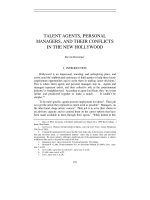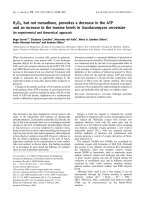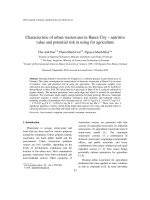Precision, Stability and Productivity Increase in Throughfeed Centerless Grinding docx
Bạn đang xem bản rút gọn của tài liệu. Xem và tải ngay bản đầy đủ của tài liệu tại đây (919.93 KB, 4 trang )
Precision, Stability and Productivity Increase in Throughfeed Centerless Grinding
I. Gallego
1
(3), R. Lizarralde
2
, D. Barrenetxea
2
, P. J. Arrazola
1
1
Manufacturing Department, Faculty of Engineering – Mondragon University, Mondragon, Spain
2
Ideko Technological Center, Elgoibar, Spain
Submitted by R. Bueno (1), San Sebastian, Spain
Abstract
Centerless grinding is a high precision manufacturing process commonly applied to the mass production of
many industrial components. However, workpiece roundness is critically affected by geometric lobing and no
practical tool has been developed to solve the problem in throughfeed working mode. Based on simulation
methods previously applied to plunge grinding, a new software tool has been developed in this work. The
software determines the optimal working configuration and can be used to reduce set-up time and improve
three important features: 1) Precision, as the roundness error is rapidly corrected at the optimal configuration.
2) Productivity, since the workpiece stock can be significantly reduced. 3) Stability, because the process is
less sensitive to the original roundness error of the workpiece.
Keywords:
Centerless grinding, Productivity, Simulation
1 INTRODUCTION
Centerless grinding is a manufacturing process widely
used as a high-productivity finishing technology. The main
advantage of this process comes from the fact that
clamping and centering operations are eliminated,
reducing operation times and allowing automation via
workpiece chargers and manipulators.
However, workpiece roundness is critically influenced by
two types of instabilities: chatter and geometric lobing.
Chatter appears as a result of the coupling between the
cutting process and the main frequencies of the machine.
Simulation of dynamic instabilities and chatter avoidance
will be treated in an upcoming paper. On the other hand,
geometric lobing may appear when the machine
configuration allows a number of lobes close to an integer
to be present in the workpiece surface (see Figure 1),
coinciding a lobe maximum in the regulating wheel with
two minima in the grinding wheel and in the blade
respectively. Under these conditions, together with its
rotation, the workpiece oscillates between the grinding
and regulating wheels during the process, leading to lobe
regeneration. On the contrary, under stable conditions,
the workpiece self-centers and high precision can be
rapidly achieved.
Figure 1: Geometric lobing in centerless grinding (size of
lobes is exaggerated).
In a previous work [1], a new practical tool developed to
facilitate the set up of plunge centerless grinding was
presented. Throughfeed grinding is much more complex
to simulate. In this operation mode, the regulating wheel
is swivelled to give the workpiece an additional axial
movement. As a result, the grinder can be continuously
fed with workpieces and productivity is significantly
increased. Nevertheless, the process may be more
difficult to set up.
This paper presents the basis of a new software tool
called SUA (Set-up Assistant), which is already
commercially available, developed to increase precision
and productivity in centerless grinding.
2 THROUGHFEED STABILITY SIMULATION
Several models have been successfully developed in the
bibliography [2-11], specially concerning plunge grinding.
In mid sixties, Rowe et al. [2] derived an equation to
obtain the roundness error as a function of the error at the
contact points, which was applied to the grinder set up
problem [3]. In 1967, Reeka [4] presented geometric
stability charts, which showed the number of lobes
generated as a function of the blade angle and the angle
between the two tangents of the workpiece with the
wheels. In the seventies and eighties, the existing models
were refined by Miyashita, Hashimoto, Rowe and other
authors [5-7], and dynamic effects were introduced in the
equations. Both Bueno et al. [8] and Zhou et al. [9]
showed that the contact stiffness is an essential
parameter to predict geometric lobing correctly. More
recently, Harrison and Pierce [10] applied the model of
Zhou to plot stability maps in plunge grinding. Finally, in
2004 Hashimoto et al. [11] presented guidelines for
determining proper set-up conditions to avoid spinners,
chatter vibration and roundness problems.
Following Furukawa et al. notation [12], let r
ω
(
ϕ
) be the
radius defect in a point in the surface defined by the angle
ϕ
. In plunge operation (Figure 2), the equation that
describes the process is:
(
)
(
)
(
)( )
(
)
ϕϕϕεϕϕεϕ
ωωωω
Hrrr +−−−−
′
=
21
1 (1)
Support blade
Grindin
g
wheel
0,0
0,2
0,4
0,6
0,8
1,0
1,2
1,4
Re
g
ulatin
g
wheel
Annals of the CIRP Vol. 55/1/2006
Figure 2: Geometric configuration in plunge grinding.
Figure 3: Geometric configuration in throughfeed grinding
(workpieces are machined in a continuous run).
This equation simply describes the displacement of the
contact point between the workpiece and the grinding
wheel due to the presence of defects on the blade and on
the regulating wheel.
ε
′
and (1-
ε
) are coefficients that
relate the movement of the workpiece with respect to the
grinding wheel originated by an unitary defect on the
blade and on the regulating wheel respectively. H
ω
(
ϕ
)
represents the distortion in the cutting depth due to the
static deflection of the grinder, the deformation at the
contact point between the workpiece and the regulating
wheel and other minor effects.
In throughfeed grinding (Figure 3),
α
angle remains
constant, but
β
varies as the workpiece goes through the
path between both wheels and the blade. Consequently,
ϕ
2
in equation (1) does not remain constant anymore and,
as a result, process simulation becomes more complex.
The solution adopted in this work has been to transform
the plunge model, which is known to be very reliable for
this type of operation [1], into a more generalised
simulation scheme for throughfeed grinding. The first step
is to calculate the actual value of
ϕ
2
as a function of the
workpiece position in its path:
()
β
λλ
λ
πϕ
−
⎟
⎟
⎠
⎞
⎜
⎜
⎝
⎛
⋅⋅+
⋅−
−=
100
0
2
sincos
sin
arctan
L
L
L
zx
zh
z (2)
λ
0
and
λ
1
are the feed and penetration angles of the
regulating wheel after truing and positioning it (Figure 4).
The next stage is to analyse the process stability degree
all along the workpiece path in the grinder. For that
purpose, the path is divided in a number of segments
(typically near one hundred) and equation (1) with the
actual value of
ϕ
2
in each position is used.
Every equation is then analysed as described in previous
works [1, 13]. Laplace transformation is applied to it with
the aim of studying unstable frequency components of the
defect function. As it is well known, the poles of the
function in the frequency domain will define whether the
process is stable or unstable. The function has a very
complex analytical form and all the significant poles
should be found by means of a highly efficient algorithm.
Levenberg-Marquardt is the most appropriate optimisation
method, as it takes advantage from the safe local
convergence given by first-order methods and the faster
convergence of second-order methods. This algorithm is
much faster than Simplex method used by Harrison and
Pearce [10], being more suitable for throughfeed grinding
due to the number of calculations that must be done.
Using the output of these calculations, stability maps can
be plotted, as is described in next section.
3 RESULTS
3.1 Stability diagram of a specific configuration
In general,
ϕ
2
angle changes considerably in throughfeed
grinding. Therefore, it is very difficult to prevent the
workpiece from passing through one geometrically
unstable segment at least. Stability diagrams provide
information about the less stable lobe component and its
stability degree all along the workpiece path. A positive
value of stability degree (
ωξ
) means that roundness error
is corrected, while a negative value indicates that lobe
regeneration is going to take place [1].
In Figure 5, three stability diagrams are plotted for
different workpiece heights: 0.75 mm, 3.5 mm and 9.5
mm. Other configuration parameters are: blade angle 30º,
wheels and workpiece diameters 632 mm, 310 mm and
33 mm respectively,
λ
0
3º,
ω
r
49 min
-1
, wheel width 500
mm, feed 2500 mm/min. The less stable component
values are shown at the bottom of the graphs.
It is important to point out that the presence of a high
order unstable component in a short section of the
stability diagram (Figure 5c) is not critical for the process,
because the amplitude of these type of components is
rapidly corrected in the rest of the path. The important
configurations to avoid are those that have: 1) Low order
components at the entry (typically 3 or 5), even in short
segments, since lobe correction is much slower in this
case. 2) High order components in a relatively long
segment (more than 20% of the path).
Figure 4: Some important parameters in throughfeed
grinding.
Grinding wheel
Regulating wheel
Workpiece exit
Workpiece entry
Feed
λ
0
α
α
β
ma
x
β
min
λ
1
λ
0
λ
z
h
h
d
z
L
x
0
Diamond
path
Workpiece
axis
Regulating wheel axis
(x
0,
y
0
,z
0
)
Y
X
θ
α
β
h
ϕ
1
ϕ
2
γ
=α+
β
Grinding wheel Regulating wheelBlade
Workpiece
(a)
(b)
(c)
Figure 5: Stability diagrams, blade angle: 30º, workpiece
height: (a) h=0.75 mm, (b) h=3.5 mm and (c) h=9.5 mm.
Due to the computational efficiency of Levenberg-
Marquardt algorithm, stability diagrams are obtained in a
few seconds with an average computer.
In the absence of vibrations, these plots may facilitate to a
large extent process setting up. As wheel diameter
changes after repeated dressing, stability diagrams may
also be used to correct workpiece height and remain at
stable configurations from the beginning to the end of
wheels life. Furthermore, roundness error decreases very
fast at optimal configuration, so productivity of
manufacturing lines may be enhanced by reducing the
stock to grind.
In addition, if high process capability (cpk) is required, the
use of stability diagrams may be very helpful, because the
final result is less sensitive to the initial profile of
workpiece, which is usually a matter of concern for
grinding companies.
3.2 Stability maps
By repeating the previous calculation for different working
configurations, stability maps can be plotted (Figure 6).
Figure 6a shows the less stable lobe components and
Figure 6b represents the global stability of the process.
The latter may be used at the first stages of the setting
up, as it clearly displays the most stable areas (in blue)
and the working configurations to avoid (dark red).
Mathematically, global stability of each lobe component
should be defined as the mean value of stability along the
path. However, to further ensure that unstable segments
are avoided, a penalty weight is applied to negative
stability values. The weight value selected in our
simulation is 2.5 for wheels of 500 mm or wider (as in
Figure 6b), which decreases linearly to 1 for wheels of
100 mm or less. The reason for this change is that, from a
stability point of view, throughfeed grinding with narrow
wheels is not very dissimilar to plunge grinding, as
ϕ
2
angle does not change very much.
(a)
(b)
Figure 6: Stability maps, wheel with: 500 mm. (a) Number
of lobes (b) Global stability degree (relative units). In blue:
stable areas. In dark red: unstable areas.
0 5 10 15 20
30
35
40
45
Workpiece height (mm)
Blade angle (º)
-0.1
0
0.1
0.2
0.3
0.4
0.5
0.6
0.7
0.8
3
5
12
14
16
18
18
20
22
23
24
24
25
25
26
26
27
27
27
28
29
29
30
31
32
Workpiece height (mm)
Blade angle (º)
0 5 10 15 20
30
35
40
45
0 50 100 150 200 250 300 350 400 450 500
-0.1
-0.08
-0.06
-0.04
-0.02
0
0.02
0.04
0.06
0.08
STABLE
INSTABLE
Workpiece position (mm)
Stability degree
3 13
7
5 30
0 50 100 150 200 250 300 350 400 450 500
-0.1
-0.08
-0.06
-0.04
-0.02
0
0.02
0.04
0.06
0
.
08
STABLE
INSTABLE
Workpiece position (mm)
Stability degree
7
5
32 30 24 18
0 50 100 150 200 250 300 350 400 450 500
-0.12
-0.1
-0.08
-0.06
-0.04
-0.02
0
0.02
0.04
0.06
0.08
STABLE
INSTABLE
Workpiece position (mm)
Stability degree
3
7 5
(a) (b)
0%0%0%
-75%
-30%
-32%
-90%
-80%
-70%
-60%
-50%
-40%
-30%
-20%
-10%
0%
A
mp
li
tu
d
e
(%)
n=3
n=5
n=27
Before After grinding
0%0%0%
-74%
-71%
-77%
n=3
n=5
n=27
Before After grinding
Figure 7: Experimental evolution of 3, 5 and 27 lobe
components, workpiece height: (a) 3.5 mm (b) 9.5 mm.
Figure 8: Global stability degree, wheel width: 200 mm.
Experimental tests were performed at the same working
conditions of Figures 5 and 6 (workpiece stock: 0.2 mm).
An amount of 36 workpieces with 3, 5 and 27 lobes were
prepared. At low workpiece height, it is very well known
that 3 lobes are formed. At h=3.5 mm (Figure 7a), the
process is stable, but the amplitude of 3 and 5
components decreases very slowly. On the contrary,
closer to the optimal working configuration, all the lobes
decrease very rapidly (Figure 7b).
3.3 Influence of wheel width on stability
Preceding maps have been obtained for a wheel width of
500 mm. For shorter wheels, there is a bigger risk of
finding a high order unstable component in a relatively
long segment.
For the purposes of comparison, Figure 8 displays the
global stability degree when the wheel width is 200 mm.
As the process is now more unstable, the information that
this graph provides is even more useful than for wider
wheels.
4 CONCLUSIONS
A new software tool has been developed to predict
geometric lobing in throughfeed grinding. Stability
determination of a specific working configuration requires
only a few seconds in an average computer.
Stability maps can be plotted by repeating the same
calculation for different workpiece heights and blade
angles. In the absence of vibrations and work rotation
instabilities, these maps are very helpful to select the
ideal working configuration and improve precision and
productivity.
Stability models provide the basis for a new simulation
tool which has been practically implemented in industry by
a software program (SUA, Set-up Assistant), which can
be incorporated into the CNC control of centerless
grinders.
5 ACKNOWLEDGMENTS
This work has been carried out with the financial support
of the Basque Country Government (projects UE 2005-4
and PI 2004-9) and the Spanish Government (projects
DPI2003-09676-C02-01 and FIT-020200-2003-72). The
authors wish to thank J. I. Marquinez for his contribution
to this work.
6 REFERENCES
[1] Lizarralde, R., Barrenetxea, D., Gallego, I.,
Marquinez, J.I., 2005, Practical Application of New
Simulation Methods for the Elimination of Geometric
Instabilities in Centerless Grinding, Annals of the
CIRP, 54/1:273-276.
[2] Rowe W.B., Koeningsberger F., 1965, The Work
Regenerative Effect in Centerless Grinding, Int. J.
Mach. Tool Des. Res., 4:175-187.
[3] Rowe W.B., Richards R.L., 1972, Geometric
Stability Charts for the Centreless Grinding Process,
J. Mech. Eng. Science, 14/2:155-158.
[4] Reeka D., 1967, On the Relationship Between the
Geometry of the Grinding Gap and the Roundness
Error in Centerless Grinding , PhD. Diss., Tech.
Hochschule, Aachen.
[5] Miyashita, M., 1972, Unstable Vibration Analysis of
Centerless Grinding System and Remedies for its
Stabilisation, Annals of the CIRP, 21/1:103-104.
[6] Miyashita M., Hashimoto F., and Kanai A., 1982,
Diagram for Selecting Chatter Free Conditions of
Centerless Grinding, Annals of the CIRP, 33/1:221-
223.
[7] Rowe, W. B., Miyashita, M., Koenig, W., 1989,
Centerless Grinding Research and Its Application,
Annals of the CIRP, 38/2:617-624
[8] Bueno R., Zaratain M., Aguinagalde J. M., 1990,
Geometric and Dynamic Stability in Centerless
Grinding, Annals of the CIRP, 39:395-398.
[9] Zhou S.S., Gartner J.R., Howes T.D., 1996, On the
Relatioship between Setup Parameters & Lobing
behavior in Centerless Grinding, Annals CIRP, 45:
341-346.
[10] Harrison A. J. L., Pearce T. R. A., 2002, Prediction
of lobe growth and decay in centreless grinding
based on geometric considerations Proc. Instn.
Mech. Engrs., Part B: J. Engineering Manufacture,
216:1201-1216.
[11] Hashimoto F., Lahoti G.D., 2004, Optimization of
Set-up Conditions for Stability of The Centerless
Grinding Process. Annals of the CIRP, 53/1:271-
274.
[12] Furukawa Y., Miyashita M., Shiozaki S., 1972,
Chatter Vibration in Centerless Grinding, Bull. of
JSME, 15, 82:544-553.
[13] Gallego, I., Barrenetxea, D., Rodríguez, A.,
Marquínez, J. I., Unanue, A, Zarate, E., 2003,
Geometric lobing suppression in centerless grinding
by new simulation techniques, The 36th CIRP-
International Seminar on Manufacturing Systems,
163-170.
0 5 10 15 20
30
35
40
45
Workpiece height (mm)
Blade angle (º)
-0.1
0
0.1
0.2
0.3
0.4
0.5

